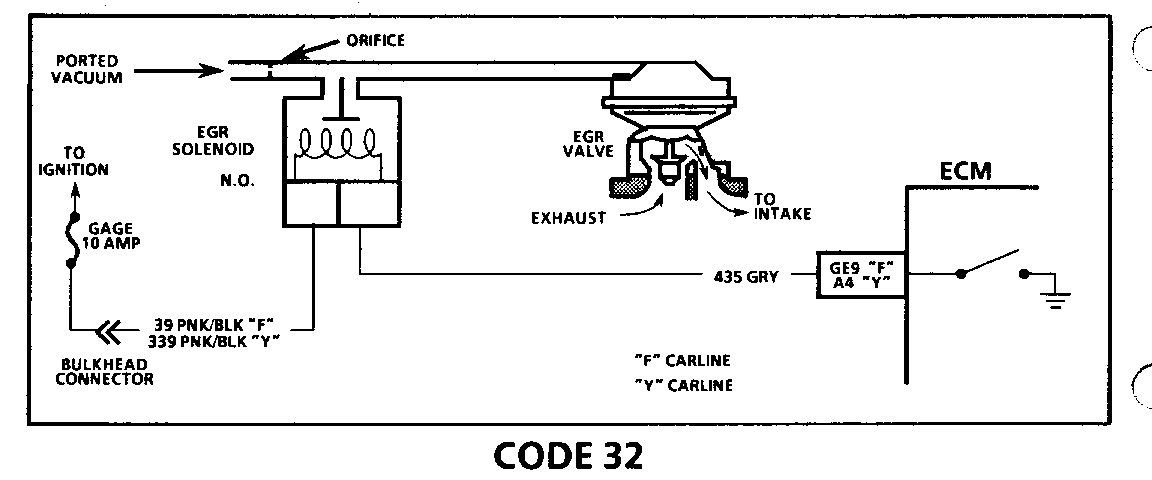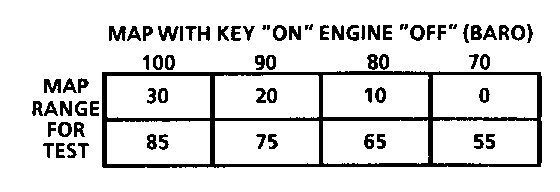SERVICE MANUAL UPDATE SEC. 6E3 DRIVEABILTY & EMISSIONS

Subject: ENHANCED EGR DIAGNOSTICS
Model and Year: 1990-91 CAMARO AND CORVETTE WITH 5.0L AND 5.7L ENGINES
This bulletin serves to enhance EGR diagnostics (Code 32) in the 1990 5.7L (VIN 8) "Y" Carline and 1990-91 5.0L (VIN F) and 5.7L (VIN 8) "F" Carline Service Manuals, Section 6E3 "Driveability And Emissions."
CODE 32 EXHAUST GAS RECIRCULATION (EGR) CIRCUIT 5.0L (VIN F) & 5.7L (VIN 8) (PORT) --------------------------------------------------------------------------- Circuit Description:
The Exhaust Gas Recirculation (EGR) valve vacuum is controlled by an ECM controlled solenoid. The ECM will turn the EGR "ON" and "OFF" (Duty Cycle) by grounding CKT 435. The duty cycle is calculated by the ECM based on information from the coolant temperature, air flow and engine rpm. There should be no EGR when in park or neutral, TPS input below a specified value, TPS indicating Wide Open Throttle (WOT), or IAT less than 15deg C (59 F) for "F" Carline or 5deg C (41 F) for Automatic Transmission "Y" Carline, and 15'C (59 F) for Manual Transmission "Y" Carline.
With the ignition "ON" engine stopped, the EGR solenoid is de-energized and by grounding the diagnostic "test" terminal, the solenoid is energized. The ECM will check EGR operation when:
o Vehicle speed is above 48 km/h (30 mph) o MAP is as listed in table (depends on altitude). o TPS is between 8% and 30% "Y" Carline. o TPS is between 5% and 30% "F" Carline. o No more than.4% change in TPS.
Test Description: Number(s) below refer to circled number(s) on the diagnostic chart.
1. By grounding the diagnostic "test" terminal, the EGR solenoid should close and hold vacuum. the vacuum may bleed off slowly, but this is not considered a fault.
2. This test will determine if the electrical control part of the system is at fault, or if the connector or solenoid are at fault.
3. By plugging the EGR valve side and ungrounding the diagnostic "test" terminal, the solenoid valve should open and allow vacuum to bleed off through the vent.
4. With the engine not running and vacuum is applied to the valve, the valve should move to the fully open position.
5. This engine uses a negative back pressure EGR valve, the valve should close when the engine is cranked over.
Diagnostic Aids:
The ECM monitors integrator during a Code 32 test and must detect a change to pass the test. If integrator is fixed too lean or fixed too rich when a Code 32 test is run, a Code 32 may set. Repair the problem which resulted in a fixed integrator.
The EGR circuit can be inoperative if the P/N switch is misadjusted or faulty. The EGR is disabled when in park or neutral. To check the P/N switch, refer to CHART C-1A.
Suction from shop exhaust hoses can alter backpressure and may effect the function of the EGR valve, during in-stall testing.
Thoroughly check that the EGR vacuum harness is not plugged or restricted. If the vacuum harness is pushed on the solenoid too far, it may plug the end of the vacuum line and cause a Code 32. Make sure vacuum lines are at the right locations of the EGR solenoid. The vacuum source goes to the orifice side of the EGR solenoid.



General Motors bulletins are intended for use by professional technicians, not a "do-it-yourselfer". They are written to inform those technicians of conditions that may occur on some vehicles, or to provide information that could assist in the proper service of a vehicle. Properly trained technicians have the equipment, tools, safety instructions and know-how to do a job properly and safely. If a condition is described, do not assume that the bulletin applies to your vehicle, or that your vehicle will have that condition. See a General Motors dealer servicing your brand of General Motors vehicle for information on whether your vehicle may benefit from the information.
